
NGC 147 is a dwarf spheroidal galaxy about 2.58 Mly away in the constellation Cassiopeia. NGC 147 is a member of the Local group of galaxies and a satellite galaxy of the Andromeda Galaxy (M31). It forms a physical pair with the nearby galaxy NGC 185, another remote satellite of M31. It was discovered by John Herschel in September 1829. Visually it is both fainter and slightly larger than NGC 185. This means that NGC 147 is more difficult to see than NGC 185, which is visible in small telescopes. In the Webb Society Deep-Sky Observer's Handbook, the visual appearance of NGC 147 is described as follows:
Large, quite faint, irregularly round; it brightens in the middle to a stellar nucleus.
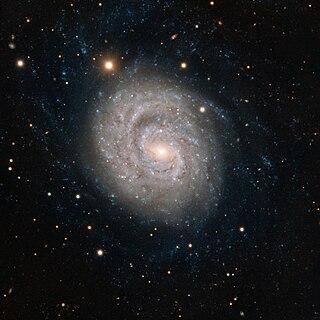
NGC 1637 is an isolated, non-interacting intermediate spiral galaxy in the constellation Eridanus, about a degree to the WNW of the star Mu Eridani. It is located at a distance of about 9.77 ± 1.82 Mpc (31.9 ± 5.9 Mly) from the Milky Way. The galaxy is inclined at an angle of 31.1° to the line of sight from the Earth and the long axis is oriented along a position angle of 16.3°.
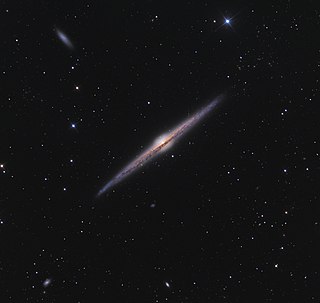
NGC 4565 is an edge-on spiral galaxy about 30 to 50 million light-years away in the constellation Coma Berenices. It lies close to the North Galactic Pole and has a visual magnitude of approximately 10. It is known as the Needle Galaxy for its narrow profile. First recorded in 1785 by William Herschel, it is a prominent example of an edge-on spiral galaxy.

Arp 271 is a pair of similarly sized interacting spiral galaxies, NGC 5426 and NGC 5427, in the constellation of Virgo. It is not certain whether the galaxies are going to eventually collide or not. They will continue interacting for tens of millions of years, creating new stars as a result of the mutual gravitational attraction between the galaxies, a pull seen in the bridge of stars already connecting the two. Located about 130 million light-years away, the Arp 271 pair is about 130,000 light-years across. It was originally discovered in 1785 by William Herschel. It is speculated, that the Milky Way will undergo a similar collision in about five billion years with the neighbouring Andromeda Galaxy, which is currently located about 2.6 million light-years away.
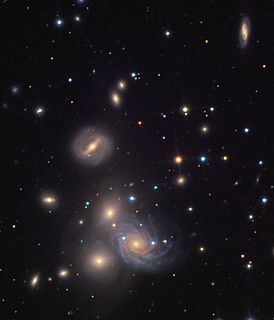
NGC 71 is an elliptical galaxy located in the constellation Andromeda. It is in the NGC 68 group. The galaxy was discovered by R. J. Mitchell in 1855, and observed in 1865 by Heinrich d'Arrest, who described it as "extremely faint, very small, round". The galaxy is about 110,000-130,000 light years across, making it just slightly larger than the Milky Way. The galaxy is the second largest in the NGC 68 group, after spiral galaxy NGC 70.
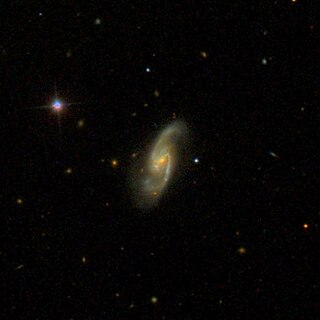
NGC 5001 is a barred spiral galaxy located in the constellation Ursa Major. It is designated as SB in the galaxy morphological classification scheme. It was discovered by John Herschel on 1 May 1831. It is at a distance of 130 million parsecs from the Earth.
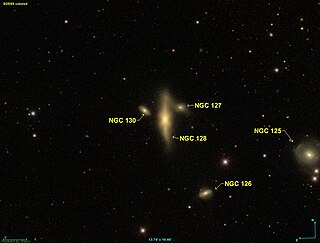
NGC 125 is a lenticular galaxy located in the constellation Pisces. It is designated as subclass Sa Ring in the galaxy morphological classification scheme. It lies approximately 235 million light-years away.

NGC 128 is a lenticular galaxy in the constellation Pisces. It is approximately 190 million light-years from the Sun and has a diameter of about 165,000 light-years.

NGC 126 is a lenticular galaxy that was discovered on November 4, 1850 by Bindon Stoney, the very same day he discovered NGC 127 and NGC 130.

NGC 127 is a lenticular galaxy that was discovered on November 4, 1850, by Bindon Stoney, the same day he discovered NGC 126 and NGC 130.

NGC 7007 is a lenticular galaxy around 130 million light-years away from Earth in the constellation Indus. NGC 7007 was discovered by astronomer John Herschel on July 8, 1834.

NGC 7081 is a spiral galaxy located about 130 million light-years away in the constellation of Aquarius. NGC 7081 was discovered by astronomer William Herschel on October 10, 1790.
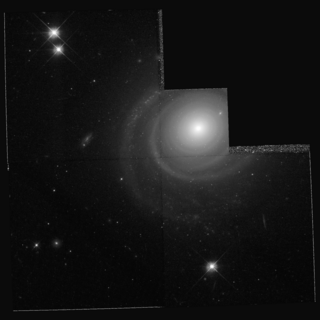
NGC 7096 is a grand-design spiral galaxy located about 130 million light-years away in the constellation of Indus. NGC 7096 is also part of a group of galaxies that contains the galaxy NGC 7083. NGC 7096 was discovered by astronomer John Herschel on August 31, 1836.

NGC 5714 is a spiral galaxy located 130 million light-years away in the constellation of Boötes. It was discovered by William Herschel in 1787. This galaxy is about 130 million light-years away.

NGC 3147 is a spiral galaxy located in the constellation Draco. It is located at a distance of circa 130 million light years from Earth, which, given its apparent dimensions, means that NGC 3147 is about 140,000 light years across. It was discovered by William Herschel on April 3, 1785. It is a Type II Seyfert galaxy.
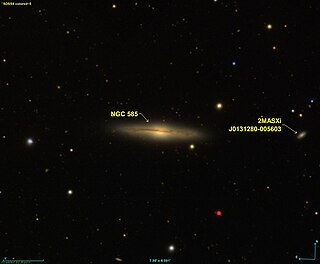
NGC 585 is a spiral galaxy in the constellation of Cetus, which is about 245 million light-years from the Milky Way 's center. The object was discovered on December 20, 1827 by the British astronomer John Frederick William Herschel.

NGC 890 is a lenticular galaxy in the constellation Triangulum. It is estimated to be 180 million light-years from the Milky Way and has a diameter of approximately 130,000 ly. NGC 890 was discovered on September 13, 1784 by Wilhelm Herschel.

NGC 644 is a barred spiral galaxy in the constellation Phoenix in the southern sky. It is estimated to be 270 million light-years from the Milky Way and has a diameter of approximately 130,000 light-years. Together with NGC 641, it probably forms a gravitationally bound pair of galaxies. The object was discovered on September 5, 1834 by John Herschel.

NGC 1439 is an elliptical galaxy located in constellation of Eridanus. Situated about 77 million light years away, it is a member of the Eridanus cluster of galaxies, a cluster of about 200 galaxies. It was discovered by William Herschel on 9 December 1784.
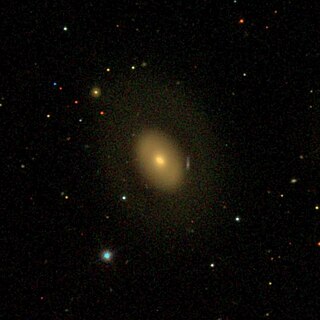
NGC 608 is a lenticular galaxy in the constellation Triangulum. It is estimated to be about 230 million light-years from the Milky Way. It has a diameter of approximately 130,000 light-years. NGC 608 was discovered on November 22, 1827 by astronomer John Herschel.



















